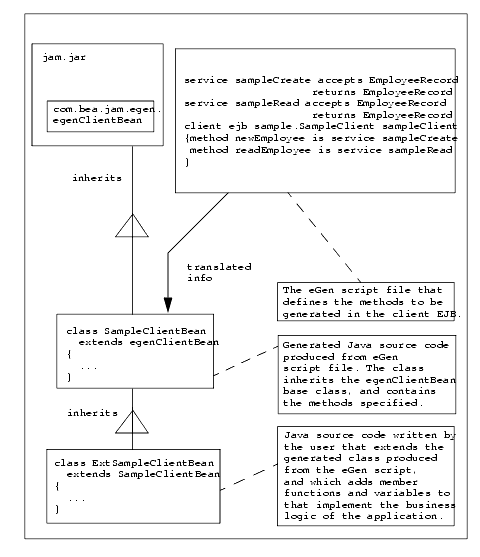


|

|
|
|
|
Generating a Client Enterprise Java Bean-based Application
This type of application produces Java classes that comprise an EJB application. The class methods are invoked from requests originating from other EJB classes and transfer data records to and from the mainframe (remote system). From the viewpoint of the mainframe, the Java classes act as a remote DTP or IMS client. From the viewpoint of the EJB classes, they act as regular EJB classes.
Action List
Before you build a Client Enterprise Java Bean-based application, see the following action list and refer to the appropriate information sources.
Prerequisites
Before you start programming your Client Enterprise Java Bean-based application, you should complete the following tasks:
Components of an eGen COBOL Client EJB Script
In order to produce an EJB-based application, the script file that defines your DataViews must be edited to describe both the mainframe services accessed and the EJB that will access them. A service description might look like the listing in Listing 3-1.
Listing 3-1 Sample service Description
service sampleCreate
accepts EmployeeRecord
returns EmployeeRecord
This sample listing defines a service named sampleCreate that accepts an input buffer of type EmployeeRecord and returns an output buffer of type EmployeeRecord. It is this service name that also requires an entry in the jcrmgw.cfg file.
An EJB that uses this service might be defined like the following listing.
Listing 3-2 Sample getSalary Service Definition
client ejb MyEJBName MyEJBHome
{
method newEmployee is service sampleCreate
}
This listing defines a Java bean class named MyEJBName with a method named newEmployee. The method corresponds to service name sampleCreate. The EJB home will be registered in Java Naming and Directory Interface (JNDI) under the name MyEJBHome.
The following listing shows the contents of a complete script file for defining a client EJB application.
Listing 3-3 Sample Client EJB Script
1 #---------------------------------------------------------
2 # empclient.egen
3 # JAM script for an employee record.
4 #
5 # $Id: empclient.egen,v 1.1 2000/01/25 18:34:14 david Exp$
6 #--------------------------------------------------------------
7
8 # DataViews (typed data records)
9
10 view sample.EmployeeRecord (Comment 1)
11 from emprec.cpy
12
13 # Services
14
15 service sampleCreate (Comment 2)
16 accepts EmployeeRecord
17 returns EmployeeRecord
18
19 service sampleRead (Comment 2)
20 accepts EmployeeRecord
21 returns EmployeeRecord
22
23 # Clients and servers
24
25 client ejb sample.SampleClient my.sampleBean (Comment 3)
26 {
27 method newEmployee (Comment 4)
28 is service sampleCreate
29
30 method readEmployee (Comment 4)
31 is service sampleRead
32 }
33
34 # End
Table 3-1 refers to the numbered comments in Listing 3-3.
Table 3-1 Script Comments
Processing the Script
Issue the following command to process the script.
Listing 3-4 Sample Script Process Command
egencobol empclient.egen
emprec.cpy, Lines: 21, Errors: 0, Warnings: 0
Generating sample.EmployeeRecord...
Generating group emp-name
Generating group emp-addr
Generating SampleClient...
Working with Generated Files
The empclient.egen script command generates the following files.
SampleClient.java Source File
The following listing shows the contents of the generated SampleClient.java source file.
Listing 3-5 Sample SampleClient.java Contents
// SampleClient.java
//
// EJB Remote Interface generated by eGenCobol on 24-Jan-2000.
package sample;
// Imports
import javax.ejb.EJBObject;
...
/** Remote Interface for SampleClient EJB. */
public interface SampleClient (Comment 1)
extends EJBObject
{
// newEmployee (Comment 2)
EmployeeRecord newEmployee (EmployeeRecord commarea)
throws RemoteException, UnexpectedException;
readEmployee (Comment 2)
EmployeeRecord readEmployee (EmploymentRecord commarea)
throws RemoteException, UnexpectedException;
}
// End SampleClient.java
Table 3-3 refers to the numbered comments in Listing 3-5.
|
Comment 1 |
Defines an EJB interface. |
|
Comment 2 |
Methods to convert a raw COMMAREA into a Java DataView object. |
SampleClientBean.java Source File
Listing 3-6 shows the contents of the generated SampleClientBean.java source file.
Listing 3-6 Sample SampleClientBean.java Contents
// SampleClientBean.java
//
// EJB generated by eGenCobol on 24-Jan-2000.
package sample;
//Imports
import com.bea.jam.egen.egenClientBean;
...
/** EJB implementation. */
public class SampleClientBean (Comment 1)
extends egenClientBean
{
// newEmployee
public EmployeeRecord newEmployee (EmployeeRecord commarea)
throws IOException, snaException (Comment 2)
{
...
}
//readEmployee
public EmployeeRecord readEmployee (EmployeeRecord commarea)
throws IOException, snaException (Comment 2)
{
...
}
}
// End SampleClientBean.java
Table 3-4 refers to the numbered comments in Listing 3-6.
|
Comment 1 |
Defines an EJB client bean. |
|
Comment 2 |
The methods convert a raw COMMAREA into a Java DataView object. |
SampleClientHome.java Source File
Listing 3-7 shows the contents of the generated SampleClientHome.java deployment descriptor file.
Listing 3-7 Sample SampleClientHome.java Contents
// SampleClientHome.java
//
// EJB Home interface generated by eGenCobol on 24-Jan-2000.
package sample;
// Imports
import javax.ejb.EJBHome;
...
/** Home interface for SampleClient EJB. */
public interface SampleClientHome (Comment 1)
extends EJBHome
{
// create
SampleClient create()
throws CreateException, remoteException;
}
// End SampleClientHome.java
Table 3-5 refers to the numbered comments in Listing 3-7.
|
Comment 1 |
Defines an EJB home interface. |
SampleClient-jar.xml Source File
Listing 3-8 shows the contents of the generated SampleClient-jar.xml deployment descriptor file.
Listing 3-8 Sample SampleClient-jar.xml Contents
<?xml version="1.0"?>
<!DOCTYPE ejb-jar PUBLIC '-//Sun Microsystems, Inc.//DTD Enterprise JavaBeans 1.1//EN''http://java.sun.com/j2ee/dtds/ejb-jar_1_1.dtd'>
<ejb-jar>
<enterprise-beans>
<session>
<ejb-name>SampleClient</ejb-name>
<home>sample.SampleClientHome</home>
<remote>sample.SampleClient</remote>
<ejb-class>sample.SampleClientBean</ejb-class>
<session-type>Stateless</session-type>
<transaction-type>Container</transaction-type>
</session>
</enterprise-beans>
<assembly-descriptor>
<container-transaction>
<method>
<ejb-name>SampleClient</ejb-name>
<method-intf>Remote</method-intf>
<method-name>*</method-name>
</method>
<trans-attribute>NotSupported</trans-attribute>
</container-transaction>
</assembly-descriptor>
</ejb-jar>
wl-SampleClient-jar.xml Source File
Listing 3-9 shows the contents of the wl-SampleClient-jar.xml source file. To use this file, copy it to weblogic-ejb-jar.xml.
Listing 3-9 Sample wl-SampleClient-jar.xml Contents
<?xml version="1.0"?>
<!DOCTYPE weblogic-ejb-jar PUBLIC '-//BEA Systems, Inc.//DTD WebLogic 5.1.0 EJB//EN' 'http://www.bea.com/servers/wls510/dtd/weblogic-ejb-jar.dtd'>
<weblogic-ejb-jar>
<weblogic-enterprise-bean>
<ejb-name>SampleClient</ejb-name>
<caching-descriptor>
<max-beans-in-free-pool>50</max-beans-in-free-pool>
</caching-descriptor>
<jndi-name>my.sampleBean</jndi-name>
</weblogic-enterprise-bean>
</weblogic-ejb-jar>
Customizing an Enterprise Java Bean-Based Application
Unlike the servlet applications, the generated Java classes produced for EJB applications are intended for customization.
This section describes the way that generated client EJB code can be customized.
The following figure illustrates the relationships and inheritance hierarchy between the JAM classes comprising the application.
Figure 3-1 The JAM Client EJB Class Hierarchy
The generated Java code for a client EJB application is a class that inherits class egenClientBean. The egenClientBean class is provided in the JAM distribution jar file. This base class, illustrated in Listing 3-10, is provided in the jam.jar file and provides the basic framework for an EJB. It provides the required methods for a Stateless Session EJB. Listing 3-10 EgenClientBean.java Base Class The generated class, illustrated in Listing 3-11, adds the methods specific to this EJB. Listing 3-11 Generated SampleClientBean.java Class Listing 3-12 illustrates an example ExtSampleClientBean class that extends the generated SampleClientBean class, adding a validation function (isSsnValid()) for the emp-ssn (m_empSsn) field of the DataView EmployeeRecord class. The four methods are overridden by the methods in the extended class. If the emp-ssn field is determined to be invalid, an exception is thrown. Otherwise, the original function is called to perform the mainframe operation. Listing 3-12 Example ExtSampleClientBean.java Class When it has been written, the ExtSampleClientBean class and the other EJB Java source files must be compiled and deployed in the same manner as other EJBs. Prior to deploying, the deployment descriptor must be modified; the ejb-class property must be set to the name of your extended EJB implementation class.
//=========================================================
// egenClientBean.java
// The base class for generated client EJB's.
//
//---------------------------------------------------------------package com.bea.jam.egen;
abstract public class EgenClientBean
implements SessionBean
{
//Implementation of ejbActivate(), ejbRemove(),
// ejbPassiveate(), ejbCreate() and setSessionContext()
... /**
* Call a service by name through the jcrmgw.
*
* @exception bea.sna.jcrmgw.snaException For Gateway errors
* @exception java.io.IOException For data translation
errors.
*/
protected byte[] callService(String service, byte[] in)
throws snaException, IOException
{
// Low level gateway access code
...
} // Variables
protected SessionContext m_context;
protected transient Properties m_properties;
}// End EgenClientBean.java
// SampleClientBean.java
//
// EJB generated by eGenCobol on Feb 2, 2000.
//package Sample;
...
/**
* EJB implementation.
*/
public class SampleClientBean extends EgenClientBean
{
// readEmployee
//
public EmployeeRecord readEmployee (EmployeeRecord commarea)
throws IOException, snaException
{
// Make the remote call.
//
...
} // newEmployee
//
public EmployeeRecord newEmployee (EmployeeRecord commarea)
throws IOException, snaException
{
// Make the remote call.
//
...
}
}// END SampleClientBean.java
//============================================================================
// ExtSampleClientBean.java
// Example class that extends a generated JAM client EJB application.
//----------------------------------------------------------------------------package sample;
// Imports
import java.math.BigDecimal;
import java.io.IOException;import com.bea.sna.jcrmgw.snaException;
// Local imports
import sample.EmployeeRecord;
import sample.SampleClientBean;/*****************************************************************************
* Extends the SampleClientBean EJB class, adding additional business logic.
*/public class ExtSampleClientBean
extends SampleClientBean
{
// Public functions /*************************************************************************
* Read an employee record.
*/ public EmployeeRecord readEmployee(EmployeeRecord commarea)
throws RemoteException, UnexpectedException, IOException, snaException
{
EmployeeRecord erec = (EmployeeRecord) commarea; if (!isSsnValid(erec.getEmpRecord().getEmpSsn()))
{
// The SSN is not valid.
throw new Error("Invalid Social Security Number: "
+ erec.getEmpRecord().getEmpSsn());
} // Make the remote call.
return super.readEmployee(commarea);
} /*************************************************************************
* Create a new employee record.
*/ public EmployeeRecord newEmployee(EmployeeRecord commarea)
throws IOException, snaException
{
EmployeeRecord erec = (EmployeeRecord) commarea; if (!isSsnValid(erec.getEmpRecord().getEmpSsn()))
{
// The SSN is not valid.
throw new Error("Invalid Social Security Number:"
+ erec.getEmpRecord().getEmpSsn());
} // Make the remote call.
return super.newEmployee(commarea);
}// Private Functions
/*************************************************************************
* Validate an SSN field.
*
* @return
* True if the SSN is valid, otherwise false.
*/ private boolean isSsnValid(final BigDecimal ssn)
{
if (ssn.longValue() < 100000000)
{
// Oops, appears to be less than 9 digits
return false;
}
return true;
}
}// End ExtSampleClientBean.java
Compiling and Deploying
Refer to the BEA WebLogic server documentation for more information. The sample file provided with WebLogic Server contains a build script for reference.
What Do I Do Next?
Refer to BEA Java Adapter for Mainframe Scenarios for detailed examples of some of the application models discussed in this guide.

|

|

|
|
|
|
Copyright © 2001 BEA Systems, Inc. All rights reserved.
|